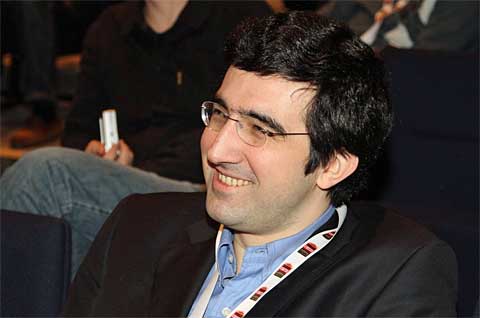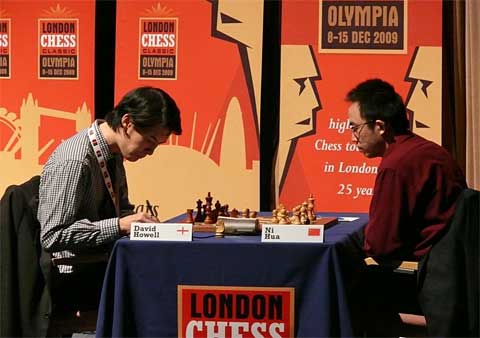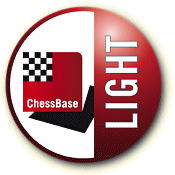
Round seven report
| Round
7: Tuesday, December 15, 2009 |
| Hikaru Nakamura |
½-½ |
Vladimir Kramnik |
| Ni Hua |
0-1 |
David Howell |
| Michael Adams |
1-0 |
Luke McShane |
| Nigel Short |
½-½ |
Magnus Carlsen |
|
For many years now there has been a unique and rather touching tradition that
the people of Norway make an annual Christmas gift to Britain of a 20-metre
high Norwegian spruce tree, which is put up in Trafalgar Square and festooned
with Christmas decorations. This year the Norwegian tree was sent to London
as usual and can be seen in all its glory in the famous square, but Norway also
thoughtfully sent another present – not as tall but every bit as impressive
to anyone who appreciates top-quality chess. 19-year-old Magnus Carlsen came,
saw and conquered at the London Chess Classic and, in the process, launched
himself to the top of the official world chess ratings. Nobody has ever achieved
this at a younger age.
So, “Magnus venit, vidit, vicit” (I knew all that school Latin
would come in handy one day)... but, before we get too carried away with all
this hyperbole, we must give credit to his last-round opponent, Nigel Short,
who gave him a terrific run for his money and provided excellent entertainment
for the chess fans at the Olympia Conference Centre.
[Addendum: “Magnus venit, vidit, vicit”
is the grammatically correct Latin translation of "The great one came,
saw and conquered", and not, as some readers have been complaining, an
erroneous rendition of the famous sentence reportedly written by Julius Caesar
in 47 BC as a comment on his short war with Pharnaces II of Pontus: "Veni,
vidi, vici", which translates to the tricolon "I came, I saw, I
conquered"].
Let’s take things chronologically. The first game to finish was Nakamura-Kramnik,
in which both players made strenuous efforts to win. Ex-world champion Vladimir
Kramnik, needing a win to give himself a realistic chance of the first prize,
gave up a rook for a bishop and pawns, and some threats against White’s
king but the American stood firm and the players eventually repeated the position
for a draw. Both players will be slightly disappointed with their final results
in London but they both deserve great credit for their part in making the tournament
a roaring success and entertaining the audience in the commentary room.

Vladimir Kramnik, very relaxed before the start of the last game

His opponent the US "H-bomb" grandmaster Hikaru Nakamura

Magnus Carlsen takes an (understandable) interest in the outcome of this game
Nakamura,Hi (2715) - Kramnik,V (2772) [D38]
Chess Classic London ENG (7), 15.12.2009
1.d4 Nf6 2.c4 e6 3.Nc3 Bb4 4.Nf3 d5 5.Qa4+ Nc6 6.e3 0-0 7.Qc2 Re8 8.Bd2
Bf8 9.a3 e5 10.dxe5 Nxe5 11.cxd5 Nxd5 12.0-0-0 Nb6 13.Ne4 Nxf3 14.gxf3 Qh4 15.Bc3
Bf5 16.Bd3 Bg6 17.f4 Rad8 18.f5 Rxd3 19.Nf6+ gxf6 20.Qxd3 Qxf2 21.fxg6 hxg6
22.Bd4 Nd5 23.Kb1 c5 24.Rhf1 Qxh2 25.Bxf6 Nxf6 26.Rxf6 Bg7 27.Qb5 Bxf6 28.Qxe8+
Kg7 29.Qb5 Qg2 30.Rd7 Qe4+ 31.Ka2 Qe6+ 32.Kb1 Qe4+ 33.Ka2 Qe6+ 34.Kb1 Qe4+ 1/2-1/2.
[Click to replay]

Kramnik and Nakamura analyse in the VIP room on a regular board, after
which...

... Kramnik proceeds to the commentary room to discuss his game to the audience
in London and the visitors on the Playchess server

Vladimir Kramnik and GM Stephen Gordon do a Q&A session
Three-time Chinese champion Ni Hua played the Ruy Lopez opening against England’s
top-rated teenager David Howell. The young man from Seaford in Sussex played
an excellent game. First he made an energetic pawn sacrifice to block up Ni
Hua’s bishop in the corner of the board and then attacked the weakened
white defences in the centre. Ni Hua used too much time at the critical juncture
and made some mistakes as his time ebbed away. David Howell made no mistake
and launched a lethal counter-attack. As the lowest-rated player in the field
as well as the least experienced, David’s final score of one win, six
draws and no losses, and third place after the two megastars, was a superb achievement.
Asked afterwards where this result ranked in his chess career, David had no
hesitation in pronouncing it his best ever.

Ni Hua (2665) - Howell,D (2597) [C84]
Chess Classic London ENG (7), 15.12.2009 [John Saunders]
1.e4 e5 2.Nf3 Nc6 3.Bb5 a6 4.Ba4 Nf6 5.d3. Not seen very often and
probably designed to dodge the more thoroughly analysed lines. 5...b5 6.Bb3
Be7 7.0-0 0-0 8.a4 Bb7 9.Nc3 b4 10.Nd5 Na5 11.Ba2 Nxd5 12.exd5. 12.Bxd5
avoids some of the problems that accrue after the text. 12...b3! This
sacrifice of a pawn is designed to make a mess of White's pawn structure and
also hem the bishop in on a2. 13.cxb3 Bxd5 14.Nxe5 Rb8 15.Nc4 Nc6 16.Bd2.
Theory in the much-analysed Ruy Lopez goes deep into the game and can be
quite antique. Here the moves 16.d4 f5 17.Ne3 Bf7 18.Nxf5 Bf6 19.Be3 Kh8 20.Rc1,
etc, were played in the game Leonhardt-Duras, Gothenburg 1909 – that's
exactly 100 years ago. 16...Be6 17.Rc1 Re8 18.Re1 Bc5
White is still a pawn up but the extra pawn is worth less to him than the powerful
dark-square grip is to Black. 19.Ne3 Ba7 20.Bc3 Nd4. White had threatened
to play d3-d4 so Black quickly slams the door on that possible escape for the
entombed a2 bishop. 21.Qh5 h6 22.Nc4 Qg5 23.Qxg5 hxg5 24.Nd2 Bf5
25.Bxd4? Faced with the attack on his d3 pawn, White should probably
just play 25.Ne4 when his position looks uncomfortable but playable. As played
the two bishops become too powerful and the d3 pawn remains under attack. 25...Bxd4
26.Ne4 Bxb2 27.Rb1 Ba3 28.f3? 28.Nxg5 Bxd3 29.Rbd1 Bc2 30.Rxe8+ Rxe8 31.Rf1
d5 leaves White with a number of positional problems to solve but the text,
played in time trouble, was worse still. 28...d5! 29.g4. 29.Nf2 Bb4
30.Rxe8+ Rxe8 31.Kf1 c5 32.Rd1 a5 33.Bb1 leaves White very tied up. 29...dxe4
30.gxf5 exd3 31.Rxe8+. The point is that a move such as 31.Red1? runs into
31...Re2 when the a2 bishop is lost. 31...Rxe8 32.Rd1 Re2 33.Bb1 d2 34.Bc2.
34.Kf1 Rxh2 wins in easy stages. 34...Bc5+ 35.Kh1. 35.Kf1 Rxh2
is hopeless. 35...a5 36.Rf1 Kf8 37.Bd1 Re1 38.Kg2 Ke7 39.Bc2 Kf6 40.h3 Ke5.
All roads lead to zugzwang. David Howell exploited his opponents weaknesses
with great skill. This game was later adjudged the best played in the round,
though there was no monetary prize for this in the last round. 0-1. [Click
to replay]
England’s Michael Adams too had an excellent last round, making the same
final score as David Howell and remaining unbeaten. His game against Luke McShane
started as a classic Adams squeeze: he applied gradual pressure to the weak
spots in his opponent’s position, to the point where Luke could barely
move. But Luke then demonstrated why he is such a dangerous fighter. His ingenious
attempts to wriggle out of trouble brought about an exceedingly complicated
position, but Adams somehow defused all the counterplay and won. This will be
great fillip to Adams and should help to narrow the rating gap between him and
England’s number one, Nigel Short. For McShane, there was tangible consolation
in the shape of the tournament brilliancy prize of 10,000 euros, given for his
win against Hikaru Nakamura in round five.
Adams,Mi (2698) - McShane,L (2615) [C95]
Chess Classic London ENG (7), 15.12.2009 [John Saunders]
1.e4 e5 2.Nf3 Nc6 3.Bb5 a6 4.Ba4 Nf6 5.0-0 Be7 6.Re1 b5 7.Bb3 d6 8.c3 0-0
9.h3 Nb8 10.d4 Nbd7 11.Nbd2 Bb7 12.Bc2 Re8 13.Nf1 Bf8 14.Ng3 c6 15.a4 Qc7 16.Be3
Rad8 17.Qc1 h6 18.b3 Qb8 19.Rb1 Qc8 20.Qb2. You are probably wondering
why no comments have appeared until now. Because it has all been played before
(as both players were aware) by Michael Adams against Alexander Morozevich in
Lugo in 2007. That game continued with 20.b4 Qc7 21.Nd2 d5 22.dxe5 Nxe5 23.Bd4
Ned7 24.exd5 Nxd5 and they then agreed a draw - not an option for the players
in London, of course. 20...Qc7 21.Rbd1 Bc8 22.c4 bxc4 23.bxc4 exd4 24.Bxd4
The Ruy Lopez is sometimes referred to as the "Spanish Torture".
Despite his mild-mannered appearance, Michael Adams is one of the most skilled
torturers in the business. He is in his element in this sort of position, gradually
creeping forward to exploit barely perceptible weakness in the enemy camp. 24...c5.
Black creates another weakness (on d5). An alternative may be 24...Re6
but it is getting uncomfortable for Black. 25.Bc3 Bb7 26.Nf5 Re6. 26...Bxe4?
27.Bxe4 Rxe4 28.Rxe4 Nxe4 29.Bxg7 would be disastrous. 27.Nd2 Rde8 28.f3
Nh5 29.Nf1 Ne5 30.N1e3 Rg6 31.Kh1 Nf4 32.Qc1 Qc8 33.Ng4
33...Nxg2?! Luke McShane feels he has to make a game of it. He could
play 33...Nh5 but one imagine the 'creeping barrage' would continue slowly with
34.a5 followed by weaving the web tighter with the knights on the kingside.
34.Kxg2 You may find your computer suggests 34.Rg1!? which could be
very good, but the super-GM prefers to keep the amount of calculation required
within bounds; he doesn't want any nasty surprises. 34...h5 35.Kf2 Nxf3!?
What was I saying about avoiding complications? Sometimes, however hard you
try to keep things under control, the position gets messy anyway. Of course,
when forced to play tactically, as here, Michael Adams is well up to the task.
36.Nfh6+! The point was that 36.Kxf3? is answered by 36...Qxf5+ 37.Qf4
hxg4+ 38.hxg4 Qe6 . But Adams answers fire with fire. 36...Kh7. 36...gxh6
37.Nf6+ Rxf6 38.Bxf6 is another variation which is hard to evaluate. 37.Kxf3
f5. 37...hxg4+ 38.Nxg4 f5 39.Ne3 leaves White's king very exposed but Black
only has a pawn for the sacrificed piece and it may not be enough. 38.Kg3!
Stepping into the line of the g6 rook's fire looks very risky but Michael has
subjected the position to some concrete analysis and worked out that he can
survive. 38...fxg4 39.e5! This opens up the b1-h7 diagonal and pins the
rook with deadly effect. 39...h4+!? 40.Kxh4! Luke gambles on some hesitation
from Michael (but is not rewarded). If White retreats with, for example, 40.Kh2??
he is lost: 40...g3+ 41.Kg1 Qxh3 and Black wins. 40...Be7+
41.Kg3. You may find your computer suggests 41.Kh5!? but it could be
quite hard for a human to figure out what is happening after, say, 41...Qe6
42.exd6 Bf3 (although a computer can find a couple of good moves easily enough).
Instead, Michael plays something more readily calculable. 41...Rf8.
41...gxh6 42.Qb1 Reg8 43.Rxd6! Bxd6 44.exd6 and now the threat of 45 Re7+ is
very powerful. 42.Rf1 gxh6 43.Qb1 h5 44.Bxg6+ Kh6 45.Bxh5 Rg8. 45...Kxh5
46.Qh7+ Kg5 47.h4# is mate. 46.Bd2+. 46.Bd2+ Bg5 47.Rf6+ mates very
soon. 1-0. [Click to replay]

Michael Adams, Luke McShane, GMs Jonathan Rowson and Stephen Gordon
in the
postgame session. McShane appeared for every game, even the ones he lost. Bravo
Luke!
That just left Magnus Carlsen’s crucial game against Nigel Short. It
lasted around five and a half hours and was a game of considerable fluctuations.
Once Kramnik had agreed a draw, Carlsen only needed a draw to secure the first
prize. However, the tournament rules precluded the agreeing of a draw in a position
with life in it, so the two players got on with the job of playing the game
through to its logical conclusion. After a fairly equal opening, Nigel Short
made a mistake around move 25, and Carlsen seemed to be on the verge of victory.
As with many sports stars on the brink of victory (e.g. a tennis player needing
to serve out for a grand slam title or a golfer needing a straightforward putt
for an open championship), nerves played their part. Magnus sometimes plays
chess like a machine but he is human like the rest of us.
The game swung in favour of Short as they reached a queen and pawns endgames
where Nigel had checkmating threats and even the chance of having two queens
operating together on the board. It was an enthralling finish for the spectators
but Carlsen recovered his equanimity and picked his way through a minefield
of tricks laid for him by the former world title challenger. At the end of the
game, just the two kings were left on the board – and there can be no
better proof of a game fought to the bitter end.

Short,N (2707) - Carlsen,M (2801) [B76]
Chess Classic London ENG (7), 15.12.2009 [John Saunders]
1.e4 c5 2.Nf3 d6 3.d4 cxd4 4.Nxd4 Nf6 5.Nc3 g6. Magnus goes for the
Sicilian Dragon, virtually guaranteeing the spectators an entertaining game.
One imagines that his coach, Garry Kasparov, would have had some say in this
opening choice. 6.Be3 Bg7 7.f3 Nc6 8.Qd2 0-0 9.0-0-0 d5 10.Kb1 Nxd4 11.e5
Nf5 12.exf6 exf6 13.Bc5. Nigel can recapture the pawn more or less when
he wants and the priority is to preserve the e3 bishop. 13...d4. Looks
very daring but the players are still following established theory. 14.Bxf8
Qxf8 15.Nb5 Ne3 16.Rc1. 16.Re1 has been played before in an obscure game
and should have continued 16...f5 17.Nxd4 f4 when Black's powerful knight on
e3 and potential pressure against the c2 pawn would have given him some compensation
for the exchange sacrifice. 16...Bh6 17.Qxd4. Giving back the exchange
is not quite forced but probably best. 17...Nf5 18.Qc3 Bxc1 19.Kxc1 Bd7 20.Bd3
Rc8 21.Qd2. 21.Qxf6 Qh6+ 22.Kb1 Bxb5 23.Bxb5 Qd2 is probably about equal.
21...Bxb5 22.Bxb5 Qc5 23.Bd3 Ne3 24.Re1 Re8
25.Qf2. After the game, Nigel berated himself for this move, though
computers seem to think better of it. The position is fairly balanced. 25...f5
26.f4?! Maybe this is some kind of concession. Fritz advocates 26.Be4!?
fxe4 27.Qxe3 Qxe3+ 28.Rxe3 f5 29.fxe4 fxe4 30.Kd2 as being a little better for
White. 26...Qd4 27.g3 Re6 28.Qd2 Ng4 29.h3?! White's position becomes
difficult after this. One neat path to a draw found by Fritz is 29.Rxe6 fxe6
30.h3 Nf2 (after 30...Nf6 White has 31.Be2!? Qg1+ 32.Qd1 Qxg3
33.Qd8+ , also with perpetual check.) 31.Bc4!? Qxc4 32.Qd8+ and it
is drawn by perpetual check. 29...Rxe1+ 30.Qxe1 Nf2 31.Bf1 Ne4 32.Bg2 b6.
White is now forced on the defensive. 33.c3 Qd3 34.g4 Ng3 35.b3.
Not 35.Qe8+?? which loses after 35...Kg7 36.Qe5+ Kh6 37.g5+ Kh5 38.b4 Ne2+ 39.Kb2
Qd2+ 40.Ka3 Nxf4, etc. 35...Ne2+ 36.Kb2 Kf8 37.Bc6 fxg4. Around here,
the commentators looked at 37...g5!? with a view to forcing a passed f-pawn.
They were working without benefit of a computer engine. Fritz gives 38.fxg5
f4 39.a4 a6 40.Bd5!? b5 41.axb5 axb5 42.Bg2 f3 43.Bf1 Kg7 and Black certainly
looks to have some chances. 38.hxg4 h5 39.gxh5 gxh5 40.a4 a6
Black cannot allow the killing Bb5. 41.f5! This maintains the balance.
Though he stays tied to the defence of his c3 pawn, White will have a few threats
of his own once this pawn comes to f6. 41...h4. 41...f6 has some merit
but White can play 42.Bb7 and it is not entirely clear if White can make progress.
42.Bg2 Ng3 43.f6 Qd6. 43...Qe2+!? 44.Qxe2 Nxe2 looks quite promising
for Black, but White may be able to hold. 44.Qf2 Kg8 45.b4 a5 46.bxa5 bxa5
47.Kc2 Kh7 48.c4 Qa3! At this stage Black is in the ascendant and White
has a difficult defensive task. 49.Be4+ Kg8. 49...Nxe4? would be very
bad: 50.Qxh4+ Kg6 51.Qxe4+ Kxf6 and only White could win. 50.Qf4 Qxa4+ 51.Kd2
Nxe4+ 52.Qxe4 Qa2+ 53.Kc3 Qa1+ 54.Kb3
54...Qd1+? What is wrong with 54...Qxf6, you ask? The answer is "nothing".
Nigel was amazed that Magnus didn't play this move, after which Black could
well be winning. 55.Kb2 Qh5?! Magnus is suffering a momentary wobble.
55...Qd2+ is the safe way to bale out for a draw (which by now was all Magnus
needed to secure a tournament victory). 56.c5! Suddenly things are not
so clear. Nigel only has two pawns to Magnus' three, but the English duo are
a couple of stops nearer their destination than the Norwegian trio, and the
f6 pawn provides the white queen with some mating possibilities.

Magnus notices to his horror that he cannot take on c5, due to the mate
threat

But like a true professional he starts afresh, now playing for a draw against
Nigel
56...h3 57.c6 a4 58.Ka2! Nigel was rightly pleased with this quiet
little move, which sets Magnus a horribly difficult puzzle to solve with only
a few seconds left on his clock. Black to play and find the only move to draw,
secure a famous tournament victory and go to number one in the world rankings.
Imagine the pressure – would Magnus do it?
58...Qd1!! Online commentator Daniel King was one of the many who were
staggered by the young man's ability to find this crucial move as his time ebbed
away. 59.Qe8+ Kh7 60.Qxf7+ Kh6
The time control. Now the players had 15 minutes each, with 30-second increments.
Perhaps I am too fanciful for my own good, but it struck me that the pawn race
was a sort of chessboard re-enactment of the 1911 race to the South Pole between
the great English hero Captain Scott and the legendary Norwegian explorer Roald
Amundsen. 61.c7 At the moment the English horses seem to have the better
of the Norwegian husky on h3. 61...Qc2+ 62.Ka3 h2! 63.Qg7+ Kh5 64.Qh8+ Kg6
65.Qg8+ Kxf6 66.c8Q Qxc8 67.Qxc8 h1Q 68.Qa6+ Ke5 69.Qb5+ Qd5 70.Kxa4 Qxb5+ 71.Kxb5
"Scott-Amundsen: The Rematch" ends in a draw. A goodly share of the
credit for some fighting chess goes to "Short of the Antarctic" but
Carlsen wins the tournament and claims the right to plant the Norwegian flag.
A fitting conclusion to an historic tournament in London. 1/2-1/2. [Click
to replay]

Young British students follow the commentary on the games
The single point gained from this draw was enough to put Magnus Carlsen just
ahead of ex-world champion Vladimir Kramnik and clinched a momentous tournament
victory. As a result of his result in London, Carlsen will become the first
teenage chessplayer in history to occupy first place in the official world rankings
(to be published on 1 January 2010).

Relieved it's over and it was a great success: chief organiser Malcolm Pein
Latest: At the gala prizegiving, held at Simpsons in the Strand
on the evening of 15 December, the trophy and winner’s cheque for 25,000
Euros was presented to the tournament winner, Magnus Carlsen. The trophy and
10,000 Euros prize for the tournament’s brilliancy prize was awarded to
Luke McShane for his round five win against Hikaru Nakamura. Malcolm Pein announced
that there would be another London tournament (dates not yet fixed) in 2010
and also that it was the intention to hold a world chess championship match
in London in 2012.
Final standings
No. |
Player |
wins |
draws |
losses |
points |
Rating |
Perf. |
1 |
Magnus Carlsen |
3 |
4 |
0 |
13 |
2801 |
2839 |
2 |
Vladimir Kramnik |
3 |
3 |
1 |
12 |
2772 |
2787 |
3 |
David Howell |
1 |
6 |
0 |
9 |
2597 |
2760 |
4 |
Michael Adams |
1 |
6 |
0 |
9 |
2698 |
2746 |
5 |
Luke McShane |
2 |
1 |
4 |
7 |
2615 |
2606 |
6 |
Ni Hua |
1 |
3 |
3 |
6 |
2665 |
2599 |
7 |
Hikaru Nakamura |
0 |
6 |
1 |
6 |
2715 |
2644 |
8 |
Nigel Short |
0 |
5 |
2 |
5 |
2707 |
2593 |
|
|
Scoring System:
3 - Points per win
1 - Point per draw
0 - Points per loss |
Traditional cross table (for rating purposes)
Schedule and results
| Round
1: Tuesday, December 8, 2009 |
Magnus Carlsen |
1-0 |
Vladimir Kramnik |
Luke McShane |
1-0 |
Nigel Short |
David Howell |
½-½ |
Michael Adams |
Hikaru Nakamura |
½-½ |
Ni Hua |
|
|
| Round
2: Wednesday, December 9, 2009 |
| Vladimir Kramnik |
1-0 |
Ni Hua |
| Michael Adams |
½-½ |
Hikaru Nakamura |
| Nigel Short |
½-½ |
David Howell |
| Magnus Carlsen |
1-0 |
Luke McShane |
|
|
| Round
3: Thuesday, December 10, 2009 |
| Luke McShane |
0-1 |
Vladimir Kramnik |
| David Howell |
½-½ |
Magnus Carlsen |
| Hikaru Nakamura |
½-½ |
Nigel Short |
| Ni Hua |
½-½ |
Michael Adams |
|
|
Friday, December 12, 2009
Rest day
|
|
| Round
4: Saturday, December 12, 2009 |
| Vladimir Kramnik |
½-½ |
Michael Adams |
| Nigel Short |
½-½ |
Ni Hua |
| Magnus Carlsen |
½-½ |
Hikaru Nakamura |
| Luke McShane |
½-½ |
David Howell |
|
|
| Round
5: Sunday, December 13, 2009 |
| David Howell |
½-½ |
Vladimir Kramnik |
| Hikaru Nakamura |
0-1 |
Luke McShane |
| Ni Hua |
0-1 |
Magnus Carlsen |
| Michael Adams |
½-½ |
Nigel Short |
|
|
| Round
6: Monday, December 14, 2009 |
| Vladimir Kramnik |
1-0 |
Nigel Short |
| Magnus Carlsen |
½-½ |
Michael Adams |
| Luke McShane |
½-½ |
Ni Hua |
| David Howell |
½-½ |
Hikaru Nakamura |
|
|
| Round
7: Tuesday, December 15, 2009 |
| Hikaru Nakamura |
½-½ |
Vladimir Kramnik |
| Ni Hua |
0-1 |
David Howell |
| Michael Adams |
1-0 |
Luke McShane |
| Nigel Short |
½-½ |
Magnus Carlsen |
|
|

































































